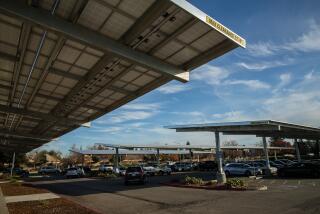China’s heralded ‘solar highway’ closed after thieves stole one of the panels
Reporting from BEIJING — It was supposed to be China’s grand “photovoltaic highway” — a solar energy-collecting, 0.6-mile stretch of road that symbolized the country’s extraordinary clean energy ambitions.
But that was last month. Five days after the road opened in the industrial city of Jinan for testing on Dec. 28, inspectors found that one six-foot panel was missing — allegedly plundered by thieves, according to the Qilu Evening News, a local newspaper. The purported thieves had also damaged seven surrounding panels. The road has since been closed.
“We can speculate the damage was not done by hand, nor does it appear it was done by a big vehicle,” Xu Dehao, a construction worker at Shandong Pavenergy, the company overseeing the project, told the newspaper. “It was more likely done by a professional team.”
Affected parts of the road appeared to be “corroded by liquid,” Xu said, adding that a nearby fence was damaged.
An unnamed Shandong Pavenergy employee told the newspaper that several suspicious figures appeared by the road as it was under construction, and that some took photos and stole components. “Now that the road is complete, they still come to steal,” the employee said. “I really don’t understand why.”
Others involved in the project warned against hasty judgment. “It is not as bad as it says in the media,” an unnamed employee at the Qilu Transportation Development Group, an investor in the project, told the newspaper. “In fact, only a small strip of the road was damaged. We are still not sure if it is stolen. The police are investigating.”
Jinan, an industrial provincial capital of nearly 7 million people, is a frequently smog-cloaked metropolis of factories and sprawling residential blocks. An aerial picture published by the state-run China Daily shows the road running straight through a wintry semi-rural landscape on the city’s South Express Ring Road, flanking a few scattered houses and patches of barren trees.
The road has three layers, according to China Daily: an insulating layer on the bottom, a middle layer of photovoltaic devices, and a protective top layer of transparent concrete.
“The top layer has good flexibility which can both withstand the pressure of large vehicles and protect the fragile amorphous silicon boards underneath,” Zhang Hongchao, an engineering expert at China’s Tongji University who helped design the project, told the state-run New China News Agency.
Zhang told CCTV, China’s state broadcaster, that the road could generate 1 million kilowatt-hours of electricity a year, enough to power 800 households. He added that it cost about $42.50 per square foot.
Electricity from the project could “melt the snow in winter to make driving safer,” state-run China Global Television Network said in a report. “It could also remote charge electric cars.”
China became the world’s top solar power producer last year; it produces 78 gigawatts of solar power annually, compared to 40.3 gigawatts in the U.S.. (The U.S. ranks fourth, after Japan and Germany).
The China Daily has billed the road as “the first photovoltaic highway in the world,” though it’s not the first road to collect solar energy. The French village of Tourouvre-au-Perche unveiled a similar-looking “solar panel road” in 2016, intended to power streetlights in the village of 3,400 people. The Netherlands built a solar panel-embedded bike path in 2014, despite public concerns about cost-effectiveness.
The Jinan highway is the largest project of its type; its solar panels cover 63,200 square feet, about twice the area of France’s road.
China has also built a 500 foot-long solar road — not quite a highway — in the eastern province Zhejiang designed to transfer solar energy into electromagnetic waves which can wirelessly charge electric vehicles.
For more news from Asia, follow @JRKaiman on Twitter
Nicole Liu in the Times’ Beijing bureau contributed to this report
More to Read
Sign up for Essential California
The most important California stories and recommendations in your inbox every morning.
You may occasionally receive promotional content from the Los Angeles Times.








